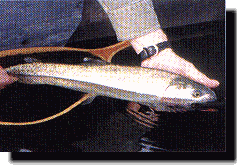|
I am not an entomologist. JC has quite a little
experience in that field, but not a degreed entomologist
either ('tho I must say his knowledge on bugs sometimes
is absolutely amazing).
So I must say I am not 'comfortable'
using a sampling tool - as a stomach or esophagus
sampling pump to find out what the trout is eating.
One of the problems is you have to
catch a fish to sample it. And if I have caught one
fish, I'd probably be inclined to keep fishing whatever
it was that caught that fish. Personal bias of course.
But then, I tend to be more of a "free spirit" rather than
a "scientific" type.
I personally don't like the idea of
sticking a tube down a trout's throat. It seems to be
unsporting. Not at all how I was raised to be a fly fisher.

That said, I do realize that fly fishers
do want to find out exactly what a trout
has just been eating. Providing of course the angler can
actually recognize the differences in insects. The catch
is improper use of a sampling device can
severely injure or kill a fish.
So if you are going to use the stomach
pump, here is the correct method. We thank Frank Amato
Publications and Brian Chan, for permission to reprint
segments and photos from the Fall 1998 issue of
Fly Tying, "What are the Trout Really Eating?
By Brian Chan.
We called Brian Chan, and asked about
the article. Brian is the Senior Fisheries Biologist for
British Columbia, and well versed in the use of what he
would prefer to call a "throat pump." (He personally only
uses one in the spring when the fish are eating tiny stuff
that may be otherwise impossible to discern.) His original
reason for writing the "What Are the Trout Really Eating?"
article was to correct the improper 'instructions' included
with the Stomach Pump marketed by Fly Rite. Instructions
which he feels can severely injure or kill the fish.
The whole process has to be done right,
beginning with the handling of the fish once it is caught.
This is really is serious stuff.
Basic Fish Handling
"There are some basic rules about handling
and selecting fish for stomach analysis. Consider sampling only
fish that are at least 12 inches in length. The esophagus
of smaller fish may not be large enough to pass the sampling
tube without causing damage. How one handles a fish for
sampling will largely determine the survival of the fish.
Keep the fish in the water. If you use a net, choose one
with a bag made of small-diameter, soft, knotless cotton
or soft fine-mesh nylon netting. These materials reduce
the amount of scale loss and damage to the protective layer
of slime on the fish. When handling a fish, cradle it from
the underside behind the pectoral fins by making a "V"
between your thumb and the other four fingers of your hand.
Don't squeeze the fish in the "V" grip, as too much pressure
can damage internal organs. Turning them on their side or
upside down can calm larger fish. After sampling, revive
the fish by moving it back and forth in the current so that well-
oxygenated water passes over the gills. Don't release a fish
until it easily swims away under its own power.
The Sampling Process
Sampling the very last food a trout has
ingested means extracting items from the esophagus or
gullet area of the digestive system. The esophagus begins
at the back of the throat. It is a short muscular section
that expands to take in larger food items. Once the
food item passes through the esophagus it enters the
stomach where digestive enzymes quickly break down and
discolor food items.
 Lubricated sampling pump with pump depressed,
ready to slide into the esophagus.
Lubricated sampling pump with pump depressed,
ready to slide into the esophagus.
Stomach or esophagus sampling pumps look
like miniature turkey basters. The end of the sampling tube is
tapered so that it will pass easily into the esophagus. A soft
rubber bulb is attached to a thin diameter plastic tube, which
is inserted into the mouth of the fish, and down to the esophagus
or stomach. Fly-Rite Inc. manufactures a stomach pump that has
a 3/16-inch inside diameter sampling tube. The tube is smoothly
finished so that it slips easily into the esophagus.
 Sampling pump positioned in
the esophageal area. Note the depressed
bulb as a result of vacuum seal.
Sampling pump positioned in
the esophageal area. Note the depressed
bulb as a result of vacuum seal.
Improper use of a sampling pump can
damage or even kill a fish. A common mistake is to fill
the bulb with water and then squeeze the bulb once the tube
is in the esophagus or stomach. The jet of water that is
shot into the stomach can rupture the digestive tract.
Pushing the sampling pump deep into the stomach also tends
to sample food items that have already been affected by
digestive enzymes and thus will not give you the most
accurate feeding pattern information.
 Pump is removed and food items
flushed into the pump bulb.
Pump is removed and food items
flushed into the pump bulb.
Small glass sample vials are excellent
viewing platforms to observe "fresh" invertebrate samples while
on the water. For instance, you can readily watch midge pupae
and mayfly nymphs, that just seconds ago were eaten by a trout,
complete the emergence into the adult stage. You will also
see how other immature insect larvae and nymphs move as well
as make notes on body colours and size of body parts.

Revival of fish prior to release.
Properly used sampling pumps are another
tool to better determine feeding patterns of trout and improve
angling success. Record this information for planning future
fishing trips to that particular water and then spend some time
at the tying bench to further refine your patterns."
Below are the step-by-step instructions
as shown in the Fly Tying article. To the
right are the instructions that accompany the Sampling Pump
from Fly-Rite.
 "Using a Sampling Pump"
"Using a Sampling Pump"
1. Flush and lubricate the pump by squeezing water in and
out of the bulb and tube.
2. Squeeze excess water out of the tube before inserting
into the mouth of the fish.
3. Depress the bulb about half way before inserting into
the fish.
4. With the bulb depressed slowly, slide the sampling tube
down into the esophagus. You will feel resistance on the
tube as it enters the muscle-lined esophagus.
5. Once into the esophagus area, release the bulb and it
will remain depressed as a vacuum seal has been formed.
6. Slowly remove the pump and, as the seal with the
esophagus is broken, air will such in the last food items
that the fish has eaten.
7. Revive and release the fish.
8. Depress the sampling bulb and fill with some water then
flush the contents into a petri dish or sampling vial for
closer observation." ~ Brian Chan
If you choose this method to find out what
the fish are eating you do have a responsibility to do it in
the most careful, considerate manner. Not something to be
taken lightly.
~Deanna Birkholm
|





